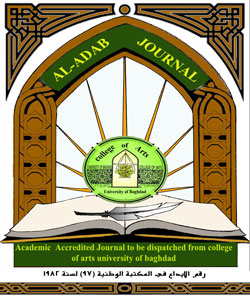Impact of cloud cover in temperatures in Iraq
DOI:
https://doi.org/10.31973/aj.v0i129.576Keywords:
Cloud cover, temperatures, IraqAbstract
The current research idea was to determine the effect of the low-altitude cloud cover at a height of less than 2500 meters from the surface of the earth at normal temperature variations during the observations )00( and )1200( GMT and compare them with the temperature of the cloudless days. Repeat the nine low clouds and determine their temporal percentages during the period (1992-2002) and selectively select four climate monitoring stations distributed geographically in a manner covering all parts of Iraq.
Statistical model (The correlation of the Hirraceae ) was applied to emphasis this relationship, So It appeared that there’s a strong relationship between the effect of the cloud presence or not on temperature rates that connected between (Ar-Rutbah and Al-Basra) stations during the observation (00)GMT. While (Baghdad and Al-Basra) stations were connected during the observation (1200)GMT. While (summer and autumn) were connected by repetition of the same kind of clouds in them and enjoyed both (winter and spring) with a group of its own far from other seasons in each of day and night monitoring.
Downloads
References
Ahmed, Yasser El Sayed, Weather and Climate, Bostan Knowledge Library, Alexandria, 2011.
Al-Fatlawi, Ne'ma Mohsen Lefta, Physics of Clouds, Dar al-Asdeqaa Press, Baghdad, 2007.
Al-Gharani, Ali Hamid Ghawi, The Repeating of Compressive Systems and their Impact on the Glimpse in Iraq, Master Thesis (unpublished), Faculty of Education for Human Sciences, Babel University, 2014.
Al-Sameraae, Qusay Abdul Majeed, Principles of Weather and Climate, Dar Al-Yazuri for Publishing and Distribution, Amman, 2008.
Geography, Adel Ali, Earth Observation of Weather, Kuwait, I 2, 1984.
Ghanim, Ali Ahmed, Geography of Climate, Dar Al-Masirah, Amman, I 3, 2011.
Gizani, Balsam Shaker Schnichl, general trends of the repetition of air masses affecting the climate of Iraq, doctoral dissertation (unpublished), College of Education for Girls, University of Baghdad, 2015.
Ministry of Transport, General Organization for Aeronautical and Seismic Monitoring, Observations of Clouds and Normal Temperature for the Period (1992-2002), unpublished data
Musa, Ali Hassan, Clouds, Encyclopedia of Science and Life, First Edition, Dar al-Fikr for Printing, Distribution and Publishing, Syria, 1988.
Republic of Iraq, Council of Ministers, Planning Authority, Central Statistical Organization, Annual Statistical Group, 2001.
Downloads
Published
Issue
Section
License
Copyright and Licensing:
For all articles published in Al-Adab journal, copyright is retained by the authors. Articles are licensed under an open access Creative Commons CC BY 4.0 license, meaning that anyone may download and read the paper for free. In addition, the article may be reused and quoted provided that the original published version is cited. These conditions allow for maximum use and exposure of the work.
Reproducing Published Material from other Publishers: It is absolutely essential that authors obtain permission to reproduce any published material (figures, schemes, tables or any extract of a text) which does not fall into the public domain, or for which they do not hold the copyright. Permission should be requested by the authors from the copyrightholder (usually the Publisher, please refer to the imprint of the individual publications to identify the copyrightholder).
Permission is required for: Your own works published by other Publishers and for which you did not retain copyright.
Substantial extracts from anyones' works or a series of works.
Use of Tables, Graphs, Charts, Schemes and Artworks if they are unaltered or slightly modified.
Photographs for which you do not hold copyright.
Permission is not required for: Reconstruction of your own table with data already published elsewhere. Please notice that in this case you must cite the source of the data in the form of either "Data from..." or "Adapted from...".
Reasonably short quotes are considered fair use and therefore do not require permission.
Graphs, Charts, Schemes and Artworks that are completely redrawn by the authors and significantly changed beyond recognition do not require permission.
Obtaining Permission
In order to avoid unnecessary delays in the publication process, you should start obtaining permissions as early as possible. If in any doubt about the copyright, apply for permission. Al-Adab Journal cannot publish material from other publications without permission.
The copyright holder may give you instructions on the form of acknowledgement to be followed; otherwise follow the style: "Reproduced with permission from [author], [book/journal title]; published by [publisher], [year].' at the end of the caption of the Table, Figure or Scheme.











